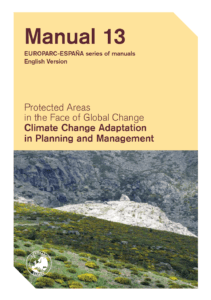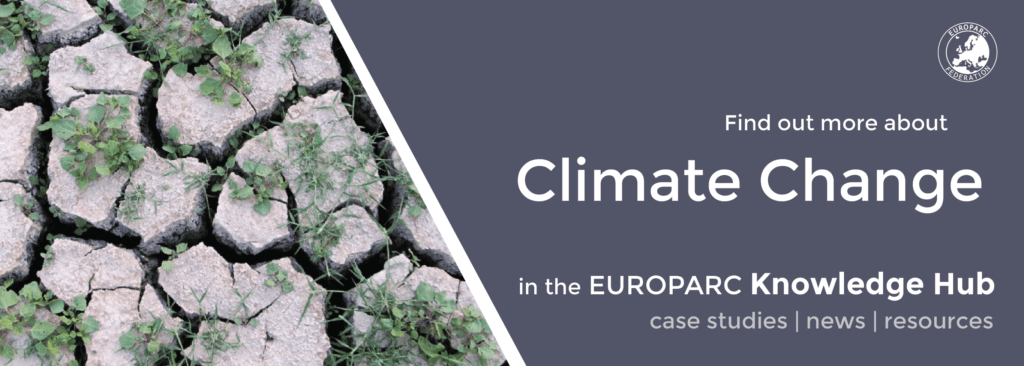[webinar] Sustainable Tourism in Protected Areas: the experience of CEETO project
Sustainable Tourism in Protected Areas: the experience of CEETO Project
- May 8th 2020
- 11:00h CET
- Participation is free, but registration is needed: https://ceetowebinar.gr8.com/
The Central Europe Eco-Tourism: tools for nature protection (CEETO) Interreg project ran for three years, to test innovative governance models for tourism development in Protected Areas. Integrating environmental, social and economic aspects, several solutions were implemented in protected areas in Austria, Germany, Croatia, Slovenia and Italy, with the aim to make tourism a real driver for nature protection and local economic and social well-being.
In this webinar, we will hear some of the best examples of the project implementation, and get access to relevant tools for Protected Area Managers and policy-makers. From Slovenia, we will hear the importance of integrating buffer zones in the management of tourism, and from Italy, we will have a technical insight into a new visitor monitoring tool.
Programme:
1) The CEETO project, an overview
Learn how CEETO project has contributed to the development of Sustainable Tourism in European Protected Areas, its goals, structure and main outputs.

By Mauro Generalli – CEETO Communication and Technical Manager at Emilia-Romagna Region – Protected Areas, Forestry and Mountains Development Department
2) The Importance of Buffer Zones: Working with Public Authorities and Privates 12 min
As part of the activities within the CEETO project, a common strategy to foster the development of sustainable tourism in the protected area was developed during a participatory process including public authorities and privates. A buffer zone has been identified as an important tool to mitigate the impact of tourism on protected areas.

By Robert Smrekar, L.L.M. – Director of the Public Institute Landscape Park Strunjan, Slovenia.
As a lawyer with vast experience in civil and public law, has been able to identify all the necessary legal aspect of the integration of buffer zones in the communication process with various stakeholders, especially regarding spatial planning and required regulation changes.
3) Nirano’s Mud Vulcanos: Identifying visitor’s profile with artificial intelligence.
In the framework of CEETO project, a Video Content Analysis (VCA) system – called NEMOS (Nature rEserve MOnitoring System) – was deployed and tested in the Integral Protected Zone of the “Salse di Nirano” Nature Reserve, Italy. By using Artificial Intelligence, NEMOS system records and provides spatial and temporal information on number of persons, vehiles and animals, density maps of the routes (heat maps) and record of events of trespassing physical barriers. This information is used to monitor the main threats existing in the Protected Area and develop mitigation measures accordingly.
 By Rudy Melli – CEO and Co-founder at Vision-e Srl, Italy, Head of the VCA system.
By Rudy Melli – CEO and Co-founder at Vision-e Srl, Italy, Head of the VCA system.
After two years at AImageLab, the Computer Vision and AI research group of the University of Modena and Reggio Emilia, working on international projects, he cofounded Vision-e: a start-up company focused on bringing these technologies at state of the art in the industrial and service fields with innovative solutions. His skills cover the understanding of images such as object detection, people tracking, face recognition; he also has strong experience in integrating these technologies to create intelligent embedded systems and industrial devices.
4) Tools for Sustainable Tourism planning and governance in Protected Areas.
CEETO project has also been a great source of knowledge from which different tools have been designed to facilitate the work of Policy Makers and Protected Area Managers in planning and implementing Sustainable Tourism. Get to know the following tools:
CEETO Manual for Protected Area Managers: a reference guide containing basic information and useful tools to development Sustainable Tourism.
 By Ana Krvarić – CEETO Project Coordinator at WWF Adria, Croatia.
By Ana Krvarić – CEETO Project Coordinator at WWF Adria, Croatia.
Ana is an expert in EU project management, with experience in cooperating with public and private sector in the process of strategic planning and implementation, as well as in the protected areas management. Since 2017, Ana is the project coordinator for the Interreg CEETO Project at WWF Adria.
CEETO Guidelines for Policy Makers: a compendium of the project results, examples and recommendations on how to gain more knowledge and reduce the impact of tourism.
 By Tina Primožic – CEETO Manager at Regionale development center Koper, Slovenia.
By Tina Primožic – CEETO Manager at Regionale development center Koper, Slovenia.
Tina Primožič graduated in geography. She joined RRC team as project Manager in 2011. Tina has experience in administrative and project management of EU projects oriented in planning at the sea and sustainable tourism and in preparing regional development plans. From 2017, she is responsible for the implementation of the project CEETO at the RRC Koper.
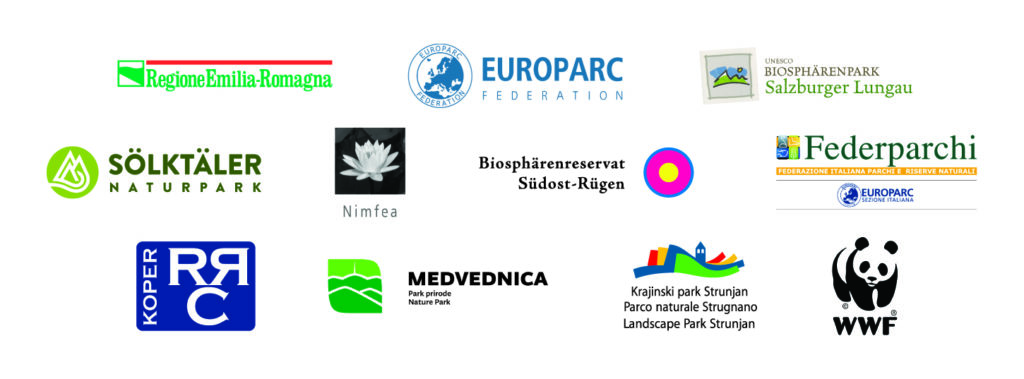
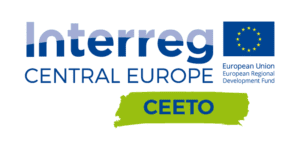
EUROPARC’s Support for the EU Green Deal
A letter to the European Union underlined EUROPARC’s support for the EU Green Deal and the important role Protected Areas play.
With a message to the president of the European Commission Mrs Ursula von der Leyen, the Executive Vice-President Mr Frans Timmermans, the President of the European parliament Mr David Sassoli and the Commissioner Mr Virginijus Sinkevičius, EUROPARC expresses full support to the EU Green Deal.
EUROPARC’s support for the EU Green Deal
We are strongly convinced that the vision expressed in the Green Deal is our life-line to a sustainable future.
If we want clean air and drinkable water for everyone. If we want a biodiverse and climate-neutral society. If we believe in justice and solidarity and if we would like to give a perspective to the future generations, for these reasons we give our full support to the EU’s Green Deal.
We are living in difficult times, but the Green Deal agenda should not be delayed, as the priorities foreseen are crucial to overcome the challenges ahead of us.
In this framework, EUROPARC firmly expresses the urgency for the approval of the EU Biodiversity Strategy 2030, a crucial pillar of the EU Green Deal. The increase of European surface protected, the promotion of specific initiatives for the restoration of habitats and ecosystems, together with targets for effective management of Natura 2000 sites and Protected Areas are all essential.
EUROPARC welcomes also the development of the EU Farm to Fork Strategy. This is another fundamental component of the EU Green Deal. The strategic vision and the power to integrate multiple policies, is a strong asset of the Green Deal. This is why EUROPARC and 18 other NGO’s joined the European Habitats Forum in sending a joint letter on biodiversity and the Farm to Fork strategy to President von der Leyen, Vice-President Timmermans and Commissioner Sinkevičius. Read the joint letter here.
Moreover, we support that Climate Policies remain high on the EU priority list.
The EU Green Deal has an enormous potential to transform our Europe. In order to fulfil its ambitions, it cannot remain a commitment on paper, but it should be applied concretely at European, national and local levels.
EUROPARC and its wide network of Protected Areas are ready and willing to play their role to contribute to implementing effectively the EU Green Deal strategies.
Read the entire letter supporting the Green Deal here (English) or here (French)!
A manual on climate change adaptation in protected areas
The manual on climate change adaptation in protected areas produced by EUROPARC Spain is now available in English.
Article by Olivier de Sadeleer, Project Manager – LIFE Natur’Adapt (Climate Change Adaptation)
We are proud to announce the release by EUROPARC-Spain of the English version of its leading-edge “Manual 13: Protected areas in the face of global change. Climate change adaptation in planning and management”.
While other drivers of change are well identified and routinely targeted by management plans (land-use changes, invasive species, or pollution), attention to climate change is still very low or often non-existent.
This is why the EUROPARC Federation and Sections are working to develop methods, tools and services that will enable managers to perform climate change vulnerability assessment and develop adaptation plans for nature protected areas.
Climate change creates even more uncertainty. It requires a new management approach. It pushes us to innovate.
said Marta Mugica, Coordinator of EUROPARC Spain, adding that “On top of keeping ecosystems in good conservation status, it is now important that we look into the future to ensure the greatest resilience possible.”
A manual on climate change adaptation in protected areas, for professionals!
Manual 13 aims at helping managers on the ground by offering guidance for major types of ecosystem. Although adaptation measures are context-specific, EUROPARC Spain compiled case studies and scientific references to build a state-of-the-art methodology to incorporate climate change adaptation measures in the design of management plans. Using this methodology, managers should be able to integrate climate change in the different phases of the planning process.
Useful links
Tracking large carnivores & tackling communication challenges
Bear and wolf photos from pixabay
Every year, the Alfred Toepfer Natural Heritage Scholarship supports the work of young conservationists in protected areas across Europe. László was one of the winners of the Scholarship in 2018. Applications for the Scholarship 2020 are now open! See how to apply here.
Article issued by László Patkó
Tracking large carnivores & tackling communication challenges
Estimated numbers of wolves (Canis lupus) and brown bears (Ursus arctos) in Europe are larger than 17.000 individuals and trends seem to continue increasing. Eurasian lynx (Lynx lynx) population estimation gives us a rough number of 9.000 individuals. After serious persecution of these species, the last decades were symbolized by a rapid recolonization into areas where their occurrence had fallen into oblivion. These landscapes have already been seriously altered by humans. There is, however, one common feature across the different European countries: carnivore return provokes opposite opinions in society.
During László’s scholarship, he focused on how people can coexist with large carnivores.
- clear scientific data (based on regular and reliable monitoring), and
- sensitization of stakeholders towards carnivores, as well as developing consensuses among stakeholders and conservation actors.
What are the right places to visit?
László Patkó’s study visit included four countries and five locations. László filmed interviews with local stakeholders and park employees. Explore his youtube channel:
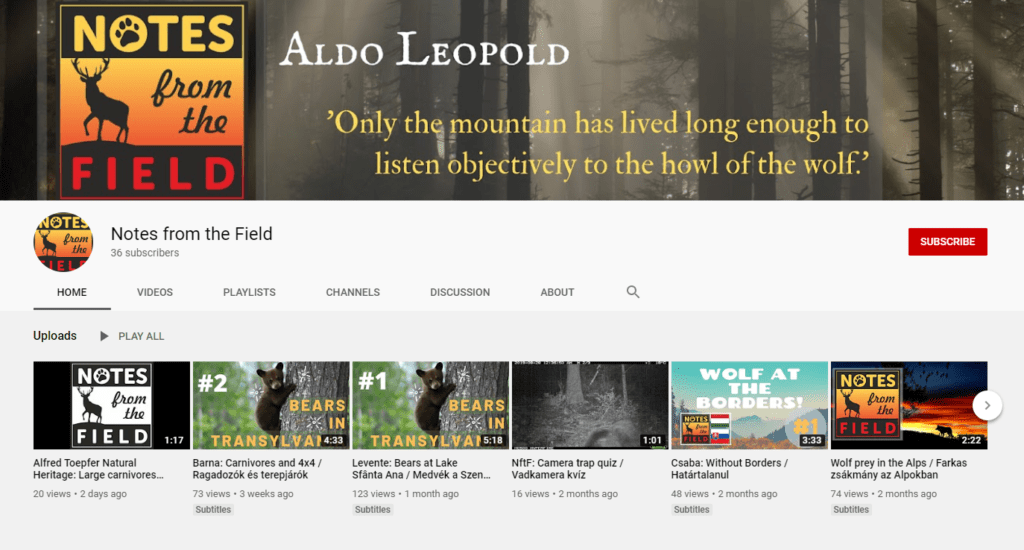
Check László´s youtube channel “Notes from the Field”
1) Italy: coexisting with wolves
The first location for a two-weeks-long period was the Alpi Marittime Nature Park in Italy. Here he learned about local involvement and coexisting with wolves. Shepherds seemed to be more open-minded towards carnivores than he previously anticipated. He had conversations on well-developed stakeholder engagement in the park with a communication expert and gathered knowledge on field and genetics monitoring, as well as wolves feeding habits from park rangers.
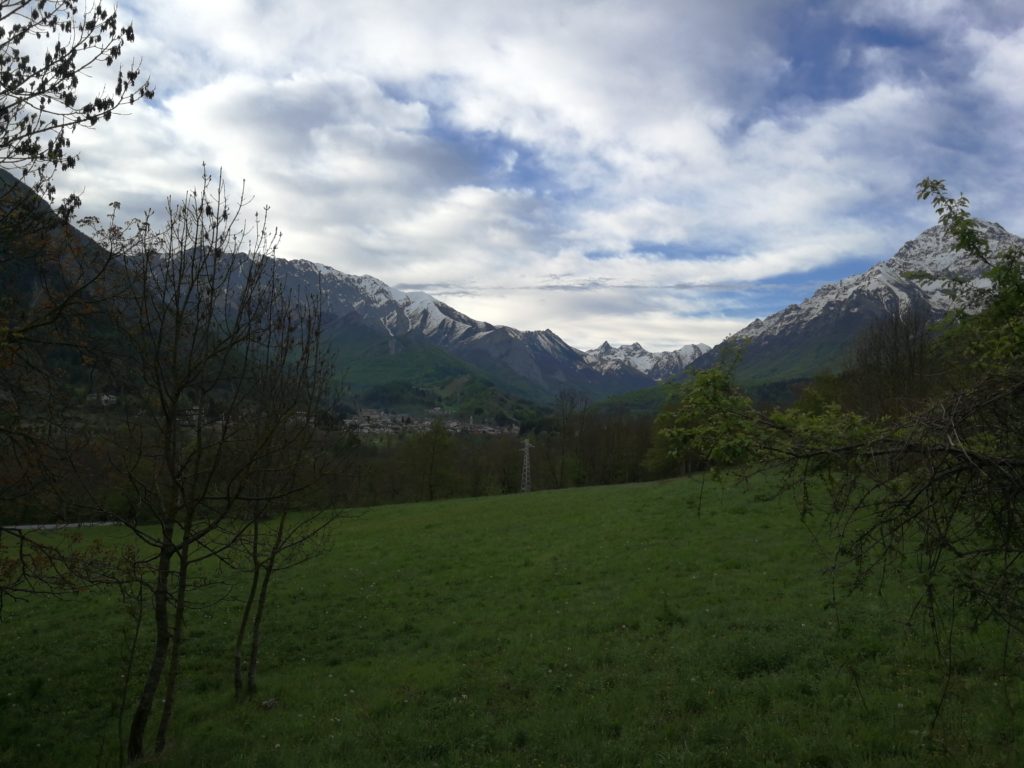
Wolf habitat in the Alpi Marittime Nature Park, Italy © László Patkó
2) Slovakia: monitoring bears
His next trip was to Cerová Vrchovina Landscape Protection Area. There, besides population monitoring, carnivore movement is also monitored with remote cameras between the Hungarian-Slovakian border. This is of high relevance in order to maintain the transboundary movements of large carnivores in the area. Another important topic in Slovakia is the game management and large carnivore conflict, which was highlighted by a hunter in the area.
At early Autumn László went to the Malá Fatra National Park where park employees have a long-standing data collection on bear presence. Here, together with local rangers, they were looking for potential bear den sites to install remote cameras for dens site monitoring.
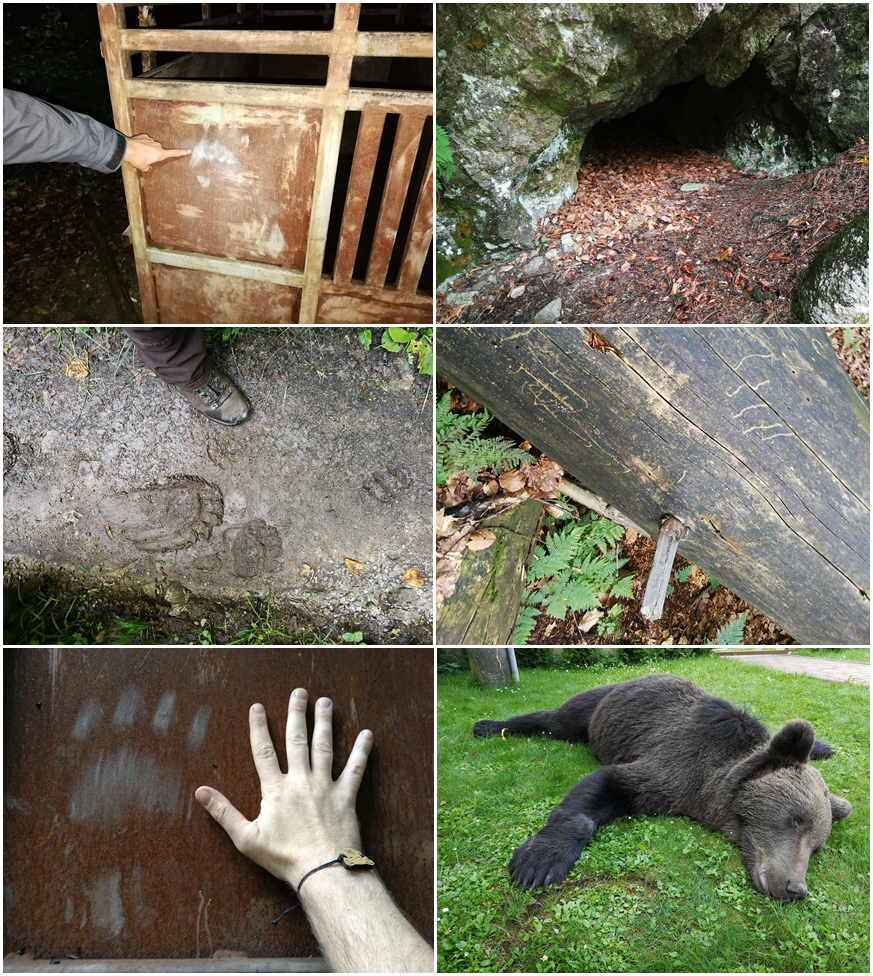
Proof of bear presence in the Mala Fatra National Park, Slovakia © László Patkó
3) Romania: mitigating conflicts with bears and the local population
László’s third destination was Cheile Bicazului-Hășmaș National Park in Transylvania, Romania. Approximately 40% of Europe’s brown bear population lives in Romania.
Romanian people have a long-standing relationship with bears, however nowadays national park employees and local wildlife face a new treat: quads and cross-country vehicles. Besides illegal driving in protected areas, Romania has a frequent conflict with habituated bears. These conflicts can be mitigated with using bear-proof bins and avoiding direct feeding of individuals, as László’s other interview partner highlighted it.
4) Hungary: participatory approaches
The last stop was Bükk National Park, where one of the two wolf populations can be found in Hungary. In these forests, migrant individuals of bears also occur every now and then. After a week-long study trip and discussions with national park personnel about the previous study trips, they came to the conclusion that countries shared one best practice: participative approach. With the help of the national park, WWF Hungary, the Sheep and Goat Breeders National Association and the Kuvasz Guard Association, the collaboration will organise a damage prevention conference for livestock breeders in Autumn, 2020.
Conclusions
László’s main finding was that we can only achieve a relatively peaceful coexistence with the help of various stakeholders. Based on the study trips the following points can ease the way into participatory approaches:
Deep understanding of different stakeholder groups. Take your time, grab a beer, start a campfire and have an honest discussion with whom you actually want to work with in the long run. Even if he or she has a different mindset from yours!
Personalizing more than one stakeholder can often help. Beside nature conservation, learn about hunters and shepherds. Even better: be one of them!
There is no such thing as “the” ranger, “the” hunter or “the” shepherd. There are people with their own agenda. Listen to them, understand them, work with them!
Find a common ground! The most controversial topics are often not the best for ice-breakers. There must be something you can work together with other stakeholders!
Establish a trust-based working environment with your stakeholders.
When you are done, you are not done. Regular communication with stakeholders is of key importance. Share your results, be transparent!
Download the full report: Tracking large carnivores and tackling communication problems
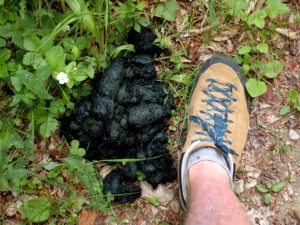
Cooperation seems to be “smelly” with people who don’t share your point of view, but this is the only way for truly coexist with each other © László Patkó
Watch the short film with the conclusions:
Bibliography
- “Notes from the Field” YouTube channel with more interviews:
- Kaczensky, P. et al. (2013) Status, management and distribution of large carnivores-bear, lynx, wolf and wolverine- in Europe. In: Report to the EU Commission, Part1.
- Chapron, G. et al. (2014) Recovery of large carnivores in Europe´s modern humandominated landscapes. Science 346(6216): 1517-1519
- Salvatori, V. et al. (2002) Hunting legislation in the Carpathian Mountains: implications for the conservation and management of large carnivores. Wildlife Biol 8(1): 3-10.
- Nowak, S., Myslajek, R. & Jedrzejewska, B. (2008) Density and demography of wolf,Canis lupus population in the western-most part of the Polish Carpathian Mountains, 1996-2003. Folia Zool 57(4): 392-402
- Chapron, G. & López-Bao, J. (2016) Coexistence with Large Carnivores Informed by Community Ecology. Trends Ecol Evol 31(8): 578-580
- Rigg, R. et al. (2011) Mitigating carnivore-livestock conflict in Europe: lessons from Slovakia. Oryx 45(2): 272-280
- Nelson, F. (2009) Developing payments for ecosystem services approaches to carnivore conservation. Hum Dim Wildlife 14(6): 381-392
- Letnic, M., Ritchie, E. & Dickman, C. (2012) Top predators as biodiversity regulators: the dingo Canis lupus dingo as a case study. Biol Rev 87: 390-413
- Ripple, W. et al. (2014) Status and ecological effects of the world’s largest carnivores. Science 343 (6167): 151-162
- Allen, B. et al. (2017) Can we save large carnivores without losing large carnivore science?. Food webs 12: 64-75
- Wilson, S. (2016) A guidebook to human-carnivore conflict: Strategies and tips for effective communication and collaboration with communities. Slovenia Forest Service – LIFE DINALP BEAR project, Ljubljana, Slovenia. 60 pp.23
- Wallach, A. et al. (2010) Predator control promotes invasive dominated ecological states. Ecol Lett 13: 1008-1018.
- van Bommel, L. & Johnson, C. (2012) Good dog! Using livestock guardian dogs to protect livestock from predators in Australia´s extensive grazing systems. Wildlife Res 39: 220-229
- Prugh, L. et al. (2009) The rise of the mesopredator. Bioscience 59(9): 779-790
- Wagner, K., Schmidt, R. & Conover, M. (1997) Compensation programs for wildlife damage in North America. Wildlife Soc B 25(2): 312-319.
- Nilsen, E. et al. (2007) Wolf reintroduction to Scotland: public attitudes and consequences for red deer management. Proc R Soc B 274: 995-1002
- Burbaité, L. & Csányi, S. (2010) Red Deer population and harvest changes in Europe. Act Zool Lit 20 (4); 179-188
- Ripple, W. & Beschta, R. (2012) Large predators limit herbivore densities in northern forest ecosystems. Eur J Wildl Res 58: 733-742
- Nowak, S., Myslajek, R. & Jedrzejewska, B. (2005) Patterns of wolf Canis lupus predation on wild and domestic ungulates in the Western Carpathian Mountains (S Poland). Acta Theriol 50(2): 263-276
- Betschta, R. & Ripple, W. (2009) Large predators and trophic cascades in terrestrial ecosystems of the western United States. Biol Conserv 142: 2401-2414
- Hebblewhite, M. et al. (2005) Human activity mediates a trophic cascade caused by wolves. Ecol 86(8): 2135-2144
- Betscha, R. & Ripple, W. (2012) The role of large predators in maintaining riparian plant communities and river morphology. Geomorphology 157-158: 88-98
- Estes, J. et al (2011) Trophic downgrading of planet Earth. Science 333: 301-306
- Schmitz, O. et al. (2013) Animating the carbon cycle. Ecosystems 10; 1-16
- Wilmers, C. et al. (2003) Trophic facilitation by introduced top predators: grey wolf subsidies to scavengers in Yellowstone National Park. J Anim Ecol 72: 909-91624
- Beekers, B. et al. (2017) Circle of life: A new way to support Europe’s scavengers. ARK Nature and Rewilding Europe. 28pp.
